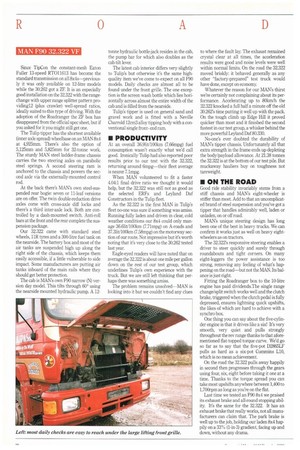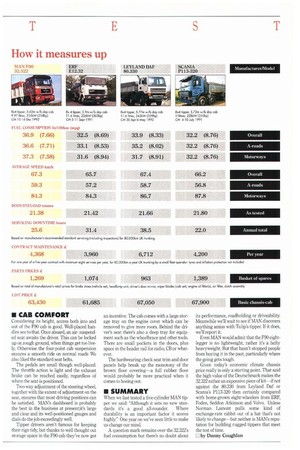Since TipCon the constant-mesh Eaton Fuller 13-speed RT011613 has become
Page 30

Page 31

If you've noticed an error in this article please click here to report it so we can fix it.
the standard transmission on all 8x4s—previously it was only available on 12-litre models while the 30.262 got a ZF. It is an especially good installation on the 32.322 with the rangechange with upper range splitter pattern providing12 (plus crawler) well-spread ratios, ideally suited to this type of driving. With the adoption of the Roadranger the ZF box has disappeared from the official spec sheet, but if you asked for it you might still get one.
The Tulip tipper has the shortest available (inner axle spread) wheelbase on an MAN 8x4 at 4,925mm. There's also the option of 5,125mm and 5,825mm for 32-tonne work. The sturdy MAN steel ladder-frame chassis carries the two steering axles on parabolic steel springs. A second steering ram is anchored to the chassis and powers the second axle via the externally-mounted control rod.
At the back there's MAN's own steel-suspended rear bogie: seven or 11-leaf versions are on offer. The twin double-reduction drive axles come with cross-axle diff locks and there's a third inter-axle lock. Both are controlled by a dash-mounted switch. Anti-roll bars at the front and the mar complete the suspension package.
Our 32322 came with standard steel wheels, 11R tyres and a 300-litre fuel tank on the nearside. The battery box and most of the air tanks are suspended high up along the right side of the chassis, which keeps them easily accessible, if a little vulnerable to side impact Some manufacturers are putting air tanks inboard of the main rails where they should get better protection.
The cab is MAN's own F90 narrow (N) version day model. This tilts through 60° using the nearside mounted hydraulic pump. A 12 tonne hydraulic bottle-jack resides in the cab, the pump bar for which also doubles as the cab tilt lever.
The latest cab interior differs very slightly to Tulip's but otherwise it's the same highquality item we've come to expect on all F90 models. Daily checks are almost all to be found under the front grille. The one exception is the screen wash bottle which lies horizontally across almost the entire width of the cab and is filled from the nearside.
Tulip's tipper is used on general sand and gravel work and is fitted with a Neville Charrold 12cm3 alloy tipping body with a conventional single frontend ram.
• PRODUCTIVITY
At an overall 36.91it/100km (7.66mpg) fuel consumption wasn't exactly what we'd call good. Ironically Tulip had also reported poor results prior to our test with the 32.322, returning around 6mpg—their fleet average is nearer 7.1mpg.
When MAN volunteered to fit a faster 4.04:1 final drive ratio we thought it would help, but the 32.322 was still not as good as the selected ERFs and Leyland Daf Constructors in the Tulip fleet.
As the 32.322 is the first MAN in Tulip's fleet no-one was sure if something was amiss. Running fully laden and driven in clear, cold weather conditions our 8x4 could only manage 36.61it/100km (7.71mpg) on A-roads and 37.31it/100km (7.58mpg) on the motorway section of our route. Not impressive but it's worth noting that it's very close to the 30.262 tested last year.
Eagle-eyed readers will have noted that on average the 32.322 is about one mile per gallon down on the rest of our test group, which underlines Tulip's own experience with the truck. But we are still left thinking that perhaps there was something amiss.
The problem remains unsolved—MAN is looking into it but we couldn't find any clues to where the fault lay. The exhaust remained crystal clear at all times, the acceleration results were good and noise levels were well within normal limits. On the road the 32.322 moved briskly: it behaved generally as any other "factory-prepared" test truck would have done, except on economy.
Whatever the reason for our MAN's thirst we're certainly not complaining about its performance. Accelerating up to 80km/h the 32.322 knocked a full half a minute off the old 30.262's time putting it well up with the pack. On the tough climb up Edge Hill it proved quicker than most and it finished the second fastest in our test group, a whisker behind the more powerful Leyland Daf 80.330.
No-one's ever doubted the durability of MAN's tipper chassis. Unfortunately all that extra strength in the frame ends up depleting the body/payload allowance. At 21.38 tonnes the 32.322 is at the bottom of our test pile. But muckaway hauliers buy on toughness not tareweight.
• ON THE ROAD
Good ride stability invariably stems from a stiff chassis and MAN's eight-wheeler is stiffer than most Add to that an uncomplicated brand of steel suspension and you've got a tipper that handles admirably well, laden or unladen, on or off mad.
MAN's unique steering design has long been one of the best in heavy trucks. We can confirm it works just as well on heavy eightwheelers as on tractors.
The 32.322's responsive steering enables a driver to steer quickly and surely through roundabouts and tight corners. On many eight-leggers the power assistance is too strong, removing any feeling of what's happening on the road—but not the MAN. Its balance is just right Fitting the Roadranger box to the 10-litre engine has paid dividends.The single range change/split switch works well and the clutch brake, triggered when the clutch pedal is fully depressed, ensures lightning quick upshifts, the likes of which are hard to achieve with a synchro box.
One thing you can say about the five-cylinder engine is that it drives like a six! It's very smooth, very quiet and pulls strongly throughout the rev range thanks to that aforementioned flat-topped torque curve. We'd go so far as to say that the five-pot D2865LF pulls as hard as a six-pot Cummins LI0, which is no mean achievement.
On the road the 32.322 pulls away happily in second then progresses through the gears using four, six, eight before taking it one at a time. Thanks to the torque spread you can take most upshifts anywhere between 1,400 to 1,700rpm as long as you're on the flat.
Last time we tested an F90 8x4 we praised its exhaust brake and all-round stopping ability. It's the same for the 32.322. It has an exhaust brake that really works, not all manufacturers can claim that. The park brake is well up to the job, holding our laden 8x4 happily on a 33% (1-in-3) gradient, facing up and down, without any drama.
• CAB COMFORT
Considering its height, access both into and out of the F90 cab is good. Well-placed handles see to that. Once aboard, an airsuspended seat awaits the driver. This can be locked up on rough ground, when things get too lively. Otherwise the four-point cab suspension ensures a smooth ride on normal roads We also liked the standard seat belts.
The pedals are small though well-placed. The throttle action is light and the exhaust brake can be reached easily, regardless of where the seat is positioned.
Two-way adjustment of the steering wheel, together with the extent of adjustment on the seat, ensures that most driving positions can be satisfied. NLAN's dashboard is probably the best in the business at present;it's large and clear and its well-positioned gauges and dials do the job exceedingly well.
Tipper drivers aren't famous for keeping their rigs tidy, but thanks to well thought out storage space in the F90 cab they've now got
an incentive. The cab comes with a large storage tray on the engine cover which can be removed to give more room. Behind the driver's seat there's also a deep tray for equipment such as the wheelbrace and other tools. There are small pockets in the doors, plus space in the header rail for radio, CB or whatever.
The hardwearing check seat trim and door panels help break up the monotony of the brown floor covering-a full rubber floor would probably be more practical when it comes to hosing out • SUMMARY
When we last tested a five-cylinder MAN tipper we said: "Although it sets no new standards it's a good all-rounder. Where durability is an important factor it scores highly." One year on we've seen little to make us change our mind.
A question mark remains over the 32.322's fuel consumption but there's no doubt about its performance, roadholding or driveability. Meanwhile we'll wait to see if MAN discovers anything amiss with Tulip's tipper. If it does, we'll report it.
Even MAN would admit that the F90 eightlegger is no lightweight, rather it's a hefty heavyweight. But that hasn't stopped people from buying it in the past, particularly where the going gets tough.
Given today's economic climate chassis price really is only a starting point. That said the high value of the Deutschmark makes the
32.322 rather an expensive piece of kit if not against the 80.330 from Leyland Daf or Scania's P113-320 then certainly compared with home-grown eight-wheelers from ERF, Foden, Seddon Atkinson and Volvo. Unless Norman Lamont pulls some kind of exchange-rate rabbit out of a hat that's not likely to change-but neither is 1VIAN's reputation for building rugged tippers that meet the test of time.
LI by Danny Coughlan




































































































